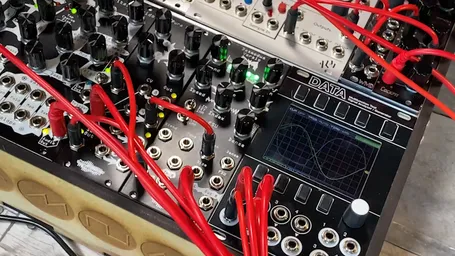A “reese” is a type of sound often found in bass music: it’s a big, wobbly-sounding thing that’s often used for basslines, low melodies, or as a sort of bassy pad. It’s a really interesting type of sound that often sounds deceptively complex. But here’s a secret: they can be really simple to patch!
Full disclosure, I’m the resident NE bass junkie and I spend a lot of time listening to drum ‘n’ bass, breakbeat, and just about anything else that resides primarily below 100hz. I’ve patched up a lot of reeses in my time, but as often as not, the simplest patch gives the best results. Those simple patches often only contain a few modules, too: I can almost guarantee you have all the modules you need to reese your heart out in your rack already.
Traditionally, a reese is made with a pair of saw waves that are mixed and slightly detuned from one another to create a beating effect. They’re then filtered, distorted, and/or processed quite heavily to give them a more unique sound. But reese-style basses can be made with other techniques, too. Synthesis techniques like FM open up lots of possibilities for reese-inspired sounds that still have that detuned, wobbly flavor, but bear only a passing resemblance to the traditional reeses of the 90s (here’s a great example at 1:08). Today we’ll play with one of these fun alternative techniques.
You can modulate a lot of things really fast
There’s a key concept we need to know to make this sort of sound work. You know all those CV inputs on your modules? Well, those aren’t just for envelopes and LFOs: many modules, especially analog ones, can be modulated at audio rates. And after a certain frequency (around 20hz), our ears stop hearing modulation as a parameter changing, and it becomes a distinct timbre instead. The useful thing about this is that you can use a simple sound, run it through a simple utility, modulate that utility at audio rates, and get a new, extremely complex sound out of it. Now, you may not want to use audio-rate modulation for every single sound you make, but it’s a handy thing to know about. And it’s how we’ll make our reeses.
A note for the cautious: you can’t hurt anything by plugging an audio-rate signal into an input. The worst thing that’ll happen is it just won’t quite work how you expected (and sometimes that makes some interesting sounds anyway!).
The patch
Learn more
The setup is pretty simple: all we need are two oscillators and a module that can process one oscillator and be modulated by the other. In this patch, we’re using the Pura Ruina, our FWR distortion, but you can use pretty much anything with an audio input and a CV input: try a filter, a wavefolder, a VCA, a phaser… the possibilities are endless.
Our first oscillator is running to the In jack on PR, and the second is running to the All CV input. Now, we could get fancy and use a mult/attenuator like the Sinc Defero to modulate each band individually, but I got some awesome sounds out of this simple arrangement. After the inputs are patched, it’s just a matter of tuning the two oscillators to frequencies that sound nice, and we’re off! If we want to control the volume of our sound, we can run the output to a VCA. Of course, we also ran it through Desmodus Versio, because pretty much everything sounds better with a little reverb.
Here, we’re sequencing the pitches of both oscillators to create a simple bassline using the patch described above. Can you believe it’s just sine waves?
Now, you may have a complex oscillator or two (or, you know, if you’re me, five) in your system, and you may notice a familiar structure here. This is very similar to how a complex oscillator works, albeit with a lot of freedom in what modulates what. The beauty of patching things like this up yourself is that you can put your signals anywhere; maybe you also want to FM the first oscillator with the second oscillator, or run it through a filter before it’s processed further? You can also use weirder oscillators in a complex fashion: if we use the patch above, we could swap the sine oscillator that’s modulating the PR for something like Manis or Ataraxic Iteritas and get something really ridiculous going.
Made some cool sounds using this technique? Tag us in a post on our instagram page! We always love hearing your patches.






